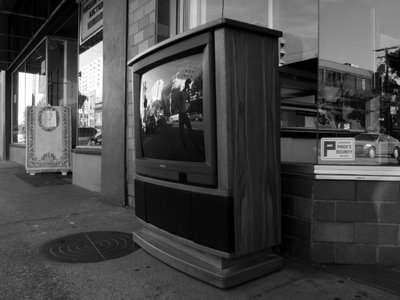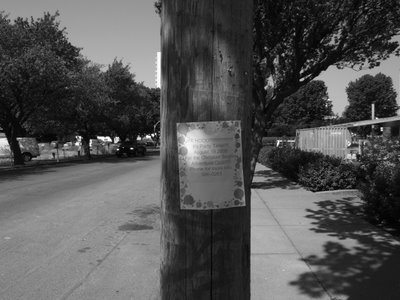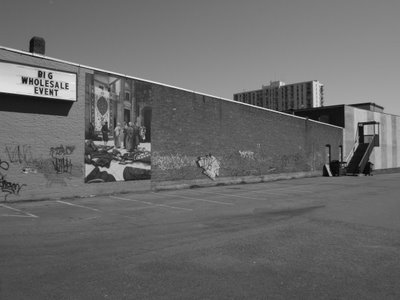Wednesday, August 30, 2006
Tuesday, August 29, 2006
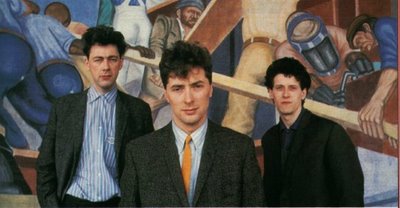 Following Steelydanodyne's lead, it's high time I fessed up to something. In the late 80's I was a card carrying fan of one of the most ridiculously stylish bands to ever walk the planet: The Blue Nile. Beginning in 1984, they released a string of critically adored/commercially ignored albums filled with some of the most sublime synth pop ever put on tape. We're talking thick "John Taylor-esque" basslines, Electronic Kurzweill strings, Reich-like guitar mantras and Processed Orchestra Hits that sound like they could have been lifted straight off of "The Terminator" soundtrack, all in service to lyrics that somehow managed to balance trembling emotions with a cool, graceful reserve. Their first two albums ( A Walk Across the Rooftops and Hats) are as goofily melodramatic and heartbreakingly aspirational as synthpop ever got, a prime example of what Clement Greenberg called "The All Out Try," that rare artistic attempt that asks for all or nothing.
Following Steelydanodyne's lead, it's high time I fessed up to something. In the late 80's I was a card carrying fan of one of the most ridiculously stylish bands to ever walk the planet: The Blue Nile. Beginning in 1984, they released a string of critically adored/commercially ignored albums filled with some of the most sublime synth pop ever put on tape. We're talking thick "John Taylor-esque" basslines, Electronic Kurzweill strings, Reich-like guitar mantras and Processed Orchestra Hits that sound like they could have been lifted straight off of "The Terminator" soundtrack, all in service to lyrics that somehow managed to balance trembling emotions with a cool, graceful reserve. Their first two albums ( A Walk Across the Rooftops and Hats) are as goofily melodramatic and heartbreakingly aspirational as synthpop ever got, a prime example of what Clement Greenberg called "The All Out Try," that rare artistic attempt that asks for all or nothing.So there, I said it. There's no turning back.
May the trucker hat wearing gods of indy hipsterism have mercy on my soul.
Monday, August 28, 2006
 White Shark, Dangerous Reef, Australia, 1974.
White Shark, Dangerous Reef, Australia, 1974.That morning the Sea Raider came out from Port Lincoln with big drums full of butchered horse; the quarters hung from the stern of the Saori, which was reeking like a charnel house. Buckets of horse blood, whale oil and a foul chum of ground tuna guts made a broad slick that spread northeast toward Spilsby Island. The cages, cameras lashed to their floors, were already overboard, floating astern. The sky was somber, with high mackerel clouds and a bank of ocean grays creeping up out of the south, and a hard wind; petrels dipped and fluttered in the wake. The ship was silent.
-A particulary McCarthy-esque passage from Peter Matthiessen's Blue Meridian, his 175 page chronicle of the now legendary 1969 Blue Water Films expedition led by Peter Gimbel and crewed by Stan Waterman, Rodney Fox, and Ron and Valerie Taylor. The expedition's goal was to capture the first ever underwater 35mm footage of great white sharks (long before most people even knew what a great white shark was) and the crew spent 9 months at sea to achieve that goal. Mattheissen's book draws on his first person experience of the journey, as well as the diaries of several of the crew. This was really the bare bones beginning of what people now consider to be routine white shark observation, and there were very few precedents at the time for the kind of underwater filming the crew was attempting.
A night dive on a whale carcass feeding frenzy:
The ocean was still very rough, and with the surge of the ship the electrical lines kept crossing and snarling; at the same time, the cages were banging together and tangling their tethers, until finally the diver's position became precarious.
At this point, Valerie wrote, Stuart Cody "leapt into the dinghy, cut the cages free from the ship, and with exceptional skill and courage proceeded to untangle the twisted mess."
In the cages, the divers were not aware that they had been cut adrift. "I wondered why we were unable to see the whale anymore," Valerie continued, "and why the light was failing, not realizing that we were no longer tethered to anything but were adrift at night, surrounded by feeding sharks under the Indian Ocean."
...Back on deck, an exhausted trembling wreck, I heard how the cages had nearly been lost when cut adrift. Stuart...had the captain maneuver the Terrier into position downstream and pick us up. Without his quick thinking we would probably still be going...
The feature length film that resulted, Blue Water, White Death, was released in 1971 and shocked audiences around the world, accustomed as they were to the gentle ocean explorations of Coustea and sons. Footage included Peter Gimbel filming a feeding frenzy from within a whale carcass, horrific night shots of clouds of feeding sharks, and of course, the first ever close up footage of the great white shark, filmed from outside the cage. After a short theater run, the film sank into deep obscurity (never released on video or dvd) that was undisturbed by even the phenomonal success of "Jaws" five years later, and the subsequent worldwide shark mania that followed. As a result, it's now become something of a holy grail for shark fanatics. Speculation abounds as to why Gimbel has kept the film locked up for so long, but I think there are clues to be found in the final pages of Blue Meridian, which quote Gimbel's diary at length.
As the expedition comes to a close, , Gimbel reflects on his final dive with the white shark:
"I felt none of the dazed sense of awe that had filled me ten days before during our first night dive. I remember wondering sadly how it could be that a sight this incredible could have lost its shattering impact so quickly for me-why it should be that the sights and sensations should have to accelerate so hellishly, simply to hold their own with my adaptation to them? Only a week or so after having come out of the water one night to say over and over, 'No four people in all the world have ever laid eyes on a scene so wild and infernal as that,' I wasn't even particularly excited...
I was filled with a terrible sadness that we had indeed determined precisely the limits we sought, that the mystery was at least partly gone."
Saturday, August 26, 2006
Just when you thought it couldn't get any worse, Robbie Benson.
 100 Views - 65
100 Views - 65 2006
Recently finished:
Sylvia Wolf - Ed Ruscha and Photography
Clement Greenberg - Homemade Esthetics
Douglas Fogle - The Last Picture Show
Cormac McCarthy - No Country for Old Men
J.M. Coetzee - Disgrace, Waiting for the Barbarians, Youth, Elizabeth Costello, Slow Man
Recently abandoned:
Russell Hoban - The Bat Tattoo
Geoff Dyer - Paris Trance
David Quamman - Monster of God
The Ruscha book was a gift from my friend Bonnie (hardcover, signed by the artist!) and one of the nicer ones I've ever received. At this point, probably the one book I would grab in a fire.
Coetzee's Disgrace and Waiting for the Barbarians are two of the best novels I've read in a long, long time, and the only two titles on the list that I'd unreservedly recommend to anyone who's reading.
Friday, August 25, 2006
Wednesday, August 23, 2006
Tuesday, August 22, 2006
Inside: Seminal works by Bernd and Hilla Becher, Louise Bourgeois, Hanne Darboven, Michael Heizer, Robert Irwin, On Kawara, Sol LeWitt, Agnes Martin, Bruce Nauman, Gerhard Richter, Joseph Beuys, Robert Ryman, Robert Smithson, Lawrence Weiner and many others; none of which manage to outdo the space itself, which at 240,000 square feet has to be one of the most completely immersive environments I've ever encountered. The kind of place that makes you acutely aware of the sound of your own footsteps.
Two Highlights:
Fred Sandback's site specific sculptures, lengths of taught, coloured yarn (which I first took for the edges of enormous glass plates) cordoning off vast, rectangular areas of gallery space in such a way as to make any traditional conception of negative and positive space, artwork and setting, completely moot. I laughed out loud when I caught myself second guessing my urge to step "through" these spaces, out of some residual fear of trespassing or respect. Through what? Into what?
Richard Serra's Torqued Ellipses, enormous Plates of Rolled Steel, each two inches thick and weighing twenty tons, configured into the most fearsome, disorientating and downright daunting gauntlet of passages imaginable. I'd read about the feelings of physical endangerment some viewers have experienced with these pieces, but I wasn't ready for the accelerated heart rate and cold sweat that they produced in me. Once inside, the weight and size of the surrounding steel walls is uncomfortably palapable. One configuration, a large circle, is accessed by squeezing through the tiniest opening imaginable, moving slowly along a sliver of a walkway between two of the plates, and eventually emerging into an inner area vastly larger than seems possible, judged from the outside. Disorientation reigns.
Other highlights: Louise Bourgeois's creepy 'attic' area of castrated cocks and crouching spiders, Gerhard Richter's enormous angled mirrors, Michael Heizer's skate bowl-like excavations of gallery floor.
Friday, August 18, 2006
Wednesday, August 16, 2006
 The late, great Spalding Grey, in conversation with Kate Miller:
The late, great Spalding Grey, in conversation with Kate Miller:KM: In Six Degrees of Separation, at the end of the movie the wife has a life-shattering epiphany that she has been turning the events in her life into anecdotes instead of using them to change her life. Do you ever feel you're anecdoting your life?
SG: Anecdoting is a defense and it's dangerous. I have to be careful with it. It's a hazard of my trade. I'm trying to work on that in therapy -- privatizing my life. I'm addicted to the joy of anecdote, the structure, the way it makes life feel cozy and meaningful. I think I experience more chaos than the average person, and this is why so many writers drink in the morning -- they're faced with the abyss. Everything is reaching out and strangling me. I think writers drink to shut down memory because memory is relentless. Everything I encounter during the day sets off associations about the past. It sets my mind going until my mind is in a painful place.
KM: Is there a certain religion you subscribe to?
SG: I'm a doubter.
KM: That's your religion? Doubt?
SG: I'm afraid it is. That and cocktail hour.
KM: There's a certain amount of spirituality in that.
SG: Yes, spirits.
Monday, August 14, 2006
 The 7th Voyage of Sinbad-1958
The 7th Voyage of Sinbad-1958Viewed last night in the great outdoors of Beacon Hill Park, as part of their summer film series. Clear skies and free admission! Free Harryhausen!
Sure the effects looked pretty clunky when viewed in the cold light of 2006 (with the striking exception of the 'shrinking of the Princess' scene, which has a strange and stately beauty that still defies description) but on the whole they've retained something that I don't think most of today's big budget effects movies will ever possess: charm. The excitement of seeing someone's personal creative struggle onscreen. These films were the bare beginnings of what Hollywood is capable of today, and they feel patched together with tape. You can practically hear Harryhausen swearing and muttering under the soundtrack, trying desperately to get his handmade beasts to cooperate with the script's near impossible demands. The results of his efforts may seem clumsy and uneven, but they are undeniably human, and I think something in us (Harryhausen's fellow humans) responds to that.
The gang of stoned hipsters who were sitting to our left would probably disagree with me. Is there anyone left of my generation who can sit through an old film without turning the proceedings into a lame episode of Mystery Science Theater 3000? At this point, taking the piss out of a Hollywood film from the 1950's is about a notch below tying your own shoes in terms of difficulty and imagination, but to listen to this group you'd think no one had ever dared attempt it. Yes, the acting is hokey, the effects are dated, the script is rife with opportunities for us to turn every single line into a smirking sexual innuendo, but we do have a choice. It's a choice that most of my generation seem to have willingly forgotten, swept away by the seemingly rapturous euphoria that results from insinuating that Sinbad is buggering the Genie. How clever of us!
There's nothing wrong with having a laugh at the hokey products of an older culture, but if the thought that we might actually gain something from these old films becomes too ridiculous for us to even contemplate, then I think we are missing out. Big time.
Sunday, August 13, 2006
Conversation I had 3 years ago with V's sister M:
M: What are you reading?
Me: Oh, it's sort of a history of global politics in the 20th century type thing.
M: (Laughs) What's it called, "Castro Kicks Everybody's Ass?"
M: What are you reading?
Me: Oh, it's sort of a history of global politics in the 20th century type thing.
M: (Laughs) What's it called, "Castro Kicks Everybody's Ass?"
Friday, August 11, 2006
Thursday, August 10, 2006
Write your own.
Dear Mr. Harper,
I'm writing to you as a former resident of Vancouver, and as someone with close friends and family who have been personally affected by addiction, to voice my support for the continued funding of Vancouver's Insite facility.
Like most British Columbians, I consider drug addiction a sickness, not a crime. The one-dimensional drug policy of the United States (a war on sick people) is not something I think Canada should emulate any longer. It's only effect (besides a zero decrease in number of drug users) has been the criminalization of thousands of innocent U.S. citizens and the swelling of U.S. jails to the breaking point.
The responsible way of dealing with the problem is through prevention and treatment. That's the approach that most civilized, progressive cities around the world have turned to with great success. The opening of Vancouver's first safe injection site in 2003 was a big step forward for Canada. The first of it's kind in North America, Insite had an almost immediate positive affect on the downtown eastside. Public injections and overdose fatalities were greatly reduced, as well as the spread of HIV and Hep C (which translates into hundreds of thousands of dollars saved by the health care system.) It offered Canadians (and Americans) a glimpse of what a sensible, humane approach to addiction treatment can look like.
Next month marks the close of Insite's first three year term, at which point you may choose to continue the project's funding or eliminate it. Your track record offers little hope to Canadians that you will choose the former. Regardless, I am writing to ask that you please consider the full gravity of your decision. Canada stands on the edge of a new approach to the treatment of it's addicts, one that would discard the outdated U.S. paradigm of intolerance and fear and offer instead compassion and treatment to it's sick citizens. Insite is the first beachhead of that approach, and has already made an important difference for residents of the downtown eastside. Let it continue to make a difference.
Sincerely,
Jamie Tolagson
Victoria, B.C.
Dear Mr. Harper,
I'm writing to you as a former resident of Vancouver, and as someone with close friends and family who have been personally affected by addiction, to voice my support for the continued funding of Vancouver's Insite facility.
Like most British Columbians, I consider drug addiction a sickness, not a crime. The one-dimensional drug policy of the United States (a war on sick people) is not something I think Canada should emulate any longer. It's only effect (besides a zero decrease in number of drug users) has been the criminalization of thousands of innocent U.S. citizens and the swelling of U.S. jails to the breaking point.
The responsible way of dealing with the problem is through prevention and treatment. That's the approach that most civilized, progressive cities around the world have turned to with great success. The opening of Vancouver's first safe injection site in 2003 was a big step forward for Canada. The first of it's kind in North America, Insite had an almost immediate positive affect on the downtown eastside. Public injections and overdose fatalities were greatly reduced, as well as the spread of HIV and Hep C (which translates into hundreds of thousands of dollars saved by the health care system.) It offered Canadians (and Americans) a glimpse of what a sensible, humane approach to addiction treatment can look like.
Next month marks the close of Insite's first three year term, at which point you may choose to continue the project's funding or eliminate it. Your track record offers little hope to Canadians that you will choose the former. Regardless, I am writing to ask that you please consider the full gravity of your decision. Canada stands on the edge of a new approach to the treatment of it's addicts, one that would discard the outdated U.S. paradigm of intolerance and fear and offer instead compassion and treatment to it's sick citizens. Insite is the first beachhead of that approach, and has already made an important difference for residents of the downtown eastside. Let it continue to make a difference.
Sincerely,
Jamie Tolagson
Victoria, B.C.
Wednesday, August 09, 2006
 "One reason why McElwee's film so bountifully transcends its limited and narcissistic premise, distinguishing itself from the mid-quality Woody Allen movies to which so many 1980s critics compared it, is that the women for whom McElwee pines emerge as layered, credible, unexpected figures in their own right—persuasive and interesting objects of love, rather than simple avatars of some generalized "womanhood" or empty mirrors in which the filmmaker sees mostly himself. Quite to the contrary, McElwee continually detects interests, expertises, energies, and even manifest foibles in these women that inspire him to be with them, and often to be like them. As much as his dashed hopes for romance provide the film's driving conceit, it is palpable throughout that he is hugely, creatively, and indeed hormonally inspired by his encounters with [them.]"
"One reason why McElwee's film so bountifully transcends its limited and narcissistic premise, distinguishing itself from the mid-quality Woody Allen movies to which so many 1980s critics compared it, is that the women for whom McElwee pines emerge as layered, credible, unexpected figures in their own right—persuasive and interesting objects of love, rather than simple avatars of some generalized "womanhood" or empty mirrors in which the filmmaker sees mostly himself. Quite to the contrary, McElwee continually detects interests, expertises, energies, and even manifest foibles in these women that inspire him to be with them, and often to be like them. As much as his dashed hopes for romance provide the film's driving conceit, it is palpable throughout that he is hugely, creatively, and indeed hormonally inspired by his encounters with [them.]"-Nick Davis
Sherman's March, Ross McElwee's 1986 cinema verite masterpiece, points like an extended finger towards a lot of other things I love. Stephen Shore's American Surfaces, Jim Jarmusch's Broken Flowers, Robert Frank's The Lines of My Hand, Chester Brown's I Never Liked You, Jem Cohen's Buried in Light, Jim McBride's David Holzmann's Diary, Walter Tevis's The Man Who Fell to Earth.
It points to these things and they point back, like ships signaling each other at sea.
If you like this, you need to get out more.
Jonathan Jones explains why Ron Mueck's much hyped figurative scupture ain't worth your time, and in doing so writes one of the best "bad" reviews I've ever read.
Jonathan Jones explains why Ron Mueck's much hyped figurative scupture ain't worth your time, and in doing so writes one of the best "bad" reviews I've ever read.
Tuesday, August 08, 2006
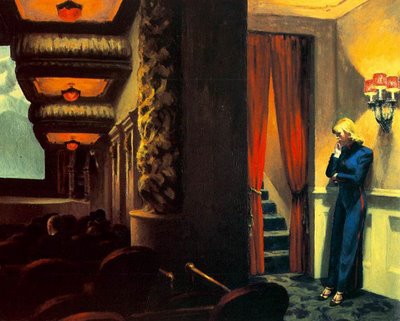 Edward Hopper, New York Movie, 1939.
Edward Hopper, New York Movie, 1939.My second favorite encounter with art in New York, also at The Whitney. There were several Hoppers on display, but this one held me the longest. It's always been a favourite, and I've probably seen 40 different reproductions of it over the years, none of which communicated the sense of light and space contained in the original. Seeing it in person made me suddenly remember why painting exists, and why photography's recent attempts to emulate it's scale and physical presence will remain just that, attempts.
About twenty or thirty charcoal and graphite studies for the finished piece were also in the room, providing some insight into Hopper's process. It was humbling to see the time, the thought, the worrying that had gone into this one painting. Lots of dead ends, abandoned ideas and "almosts," discarded on the long road to a single image. Tons of compositional options, the stairway moved here, there, up, down, flipped over to the other side, you name it. Then finally a suite of 6 or 7 exploratory studies of the girl herself, deciding on the pose, nailing down the light, closing in. This painting was thoroughly, and decidedly conceived.
I wonder sometimes, how many people realize the gauntlet that good works of art have travelled to reach them.
On a side note: Todd Haynes, who made one of my favorite films of all time, reproduced New York Movie in his 2002 film Far From Heaven.
He talks about the painting, and Hopper in general, here.
Friday, August 04, 2006
Wednesday, August 02, 2006
 Rick Moranis as Larry Siegel. Nuff said.
Rick Moranis as Larry Siegel. Nuff said.
Tuesday, August 01, 2006
 Jennifer May, Woodstock, N.Y. 2006.
Jennifer May, Woodstock, N.Y. 2006.Another round of musical chairs over at the site- more new stuff, more shuffling, more discarding.
As usual, just hit "reload" or "refresh" if the new stuff doesn't show up. First two sections have been altered, everything else is the same.
